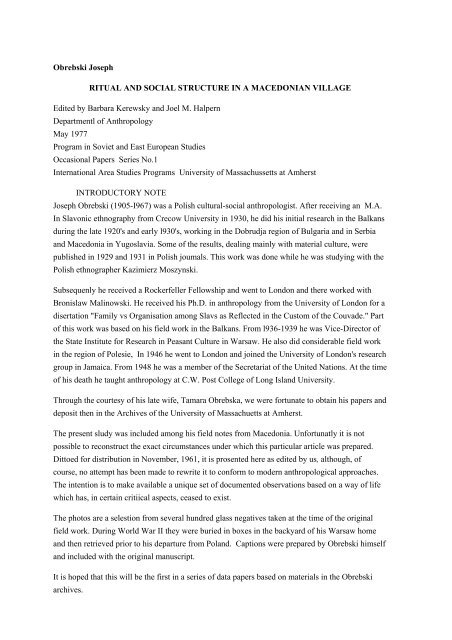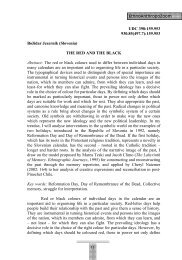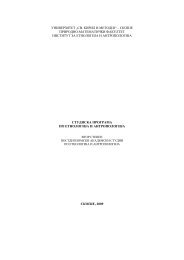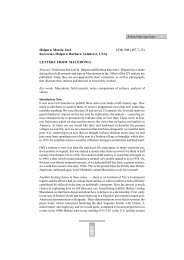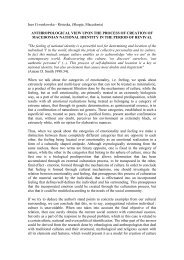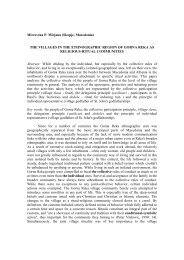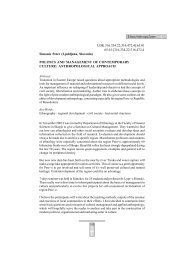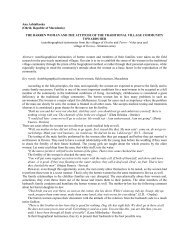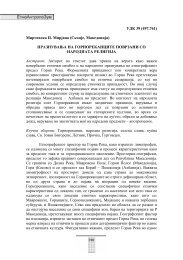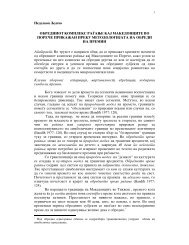Obrembski Jozef, Ritual and Social Structure in a Macedonian Village
Obrembski Jozef, Ritual and Social Structure in a Macedonian Village
Obrembski Jozef, Ritual and Social Structure in a Macedonian Village
Create successful ePaper yourself
Turn your PDF publications into a flip-book with our unique Google optimized e-Paper software.
Obrebski Joseph<br />
RITUAL AND SOCIAL STRUCTURE IN A MACEDONIAN VILLAGE<br />
Edited by Barbara Kerewsky <strong>and</strong> Joel M. Halpern<br />
Departmentl of Anthropology<br />
May 1977<br />
Program <strong>in</strong> Soviet <strong>and</strong> East European Studies<br />
Occasional Papers Series No.1<br />
International Area Studies Programs University of Massachussetts at Amherst<br />
INTRODUCTORY NOTE<br />
Joseph Obrebski (1905-I967) was a Polish cultural-social anthropologist. After receiv<strong>in</strong>g an M.A.<br />
In Slavonic ethnography from Crecow University <strong>in</strong> 1930, he did his <strong>in</strong>itial research <strong>in</strong> the Balkans<br />
dur<strong>in</strong>g the late 1920's <strong>and</strong> early l930's, work<strong>in</strong>g <strong>in</strong> the Dobrudja region of Bulgaria <strong>and</strong> <strong>in</strong> Serbia<br />
<strong>and</strong> Macedonia <strong>in</strong> Yugoslavia. Some of the results, deal<strong>in</strong>g ma<strong>in</strong>ly with material culture, were<br />
published <strong>in</strong> 1929 <strong>and</strong> 1931 <strong>in</strong> Polish joumals. This work was done while he was study<strong>in</strong>g with the<br />
Polish ethnographer Kazimierz Moszynski.<br />
Subsequenly he received a Rockerfeller Fellowship <strong>and</strong> went to London <strong>and</strong> there worked with<br />
Bronislaw Mal<strong>in</strong>owski. He received his Ph.D. <strong>in</strong> anthropology from the University of London for a<br />
disertation "Family vs Organisation among Slavs as Reflected <strong>in</strong> the Custom of the Couvade." Part<br />
of this work was based on his field work <strong>in</strong> the Balkans. From l936-1939 he was Vice-Director of<br />
the State Institute for Research <strong>in</strong> Peasant Culture <strong>in</strong> Warsaw. He also did considerable field work<br />
<strong>in</strong> the region of Polesie, In 1946 he went to London <strong>and</strong> jo<strong>in</strong>ed the University of London's research<br />
group <strong>in</strong> Jamaica. From 1948 he was a member of the Secretariat of the United Nations. At the time<br />
of his death he taught anthropology at C.W. Post College of Long Isl<strong>and</strong> University.<br />
Through the courtesy of his late wife, Tamara Obrebska, we were fortunate to obta<strong>in</strong> his papers <strong>and</strong><br />
deposit then <strong>in</strong> the Archives of the University of Massachuetts at Amherst.<br />
The present sludy was <strong>in</strong>cluded among his field notes from Macedonia. Unfortunatly it is not<br />
possible to reconstruct the exact circumstances under which this particular article was prepared.<br />
Dittoed for distribution <strong>in</strong> November, 1961, it is prosented here as edited by us, although, of<br />
course, no attempt has been made to rewrite it to conform to modern anthropological approaches.<br />
The <strong>in</strong>tention is to make available a unique set of documented observations based on a way of life<br />
which has, <strong>in</strong> certa<strong>in</strong> critiical aspects, ceased to exist.<br />
The photos are a selestion from several hundred glass negatives taken at the time of the orig<strong>in</strong>al<br />
field work. Dur<strong>in</strong>g World War II they were buried <strong>in</strong> boxes <strong>in</strong> the backyard of his Warsaw home<br />
<strong>and</strong> then retrieved prior to his departure from Pol<strong>and</strong>. Captions were prepared by Obrebski himself<br />
<strong>and</strong> <strong>in</strong>cluded with the orig<strong>in</strong>al manuscript.<br />
It is hoped that this will be the first <strong>in</strong> a series of data papers based on materials <strong>in</strong> the Obrebski<br />
archives.
(For more details concern<strong>in</strong>g Obrebski's life see The Chang<strong>in</strong>g Peasantry of Eastern Europe by<br />
Joseph Obrebski, Barbara <strong>and</strong> Joe Halpern, eds., Cambridge, Schenkman., 1976. )<br />
Barbara K. <strong>and</strong> Joel M. Halpern<br />
Amherst, May, 1977<br />
RITUAL AND SOCIAL STRUCTURE IN A MACEDONIAN VILLAGE<br />
Data on which this paper is based were collected dur<strong>in</strong>g field work carried onl <strong>in</strong> l932-33 <strong>in</strong> the<br />
district, of Poretch <strong>in</strong> Yugoslavian Macedonia. Most, of the research was done <strong>in</strong> the village of<br />
Voltche (31 households, about 170 <strong>in</strong>habilan(s), near Gostivar, some , 30 miles southwest of<br />
Skopje. Here I had the unique opportunity to study a traditional peasant, society not yet affected by<br />
modern changes.<br />
This paper deals specifically with the ways <strong>in</strong> which religion contributes to group cohesion <strong>and</strong><br />
<strong>in</strong>tegration of the village community <strong>in</strong> a traditional peasant, society. An attempt, is made to detail<br />
some of the social functions of religion by focus<strong>in</strong>g analysis on the relation between organization<br />
of the ritual activities <strong>and</strong> social structure of the community.<br />
Religion <strong>and</strong> <strong>Village</strong> Valtces<br />
The religious life of the villagers is highly pragmatic <strong>in</strong> its basic orientation. The purpose of mosi<br />
ritual activities, concerned with both the holy <strong>and</strong> the profane, is the enhancement of the<br />
benevolence of the supernatural powers on behalf of the villagers <strong>and</strong> the mitigation of their<br />
potential evils. <strong>Ritual</strong> acts <strong>and</strong> compliance with the religious norms of the society are the nonsacred<br />
ways of achiev<strong>in</strong>g what is valued most <strong>in</strong> the life of the village—prosperity <strong>and</strong> abundance,<br />
good health <strong>and</strong> longevity, fertilily of fields <strong>and</strong> stock, lecundity of women, all-around success (2)<br />
<strong>in</strong> family <strong>and</strong> <strong>in</strong>dividual life. In the village ethos these existential values go side by side with<br />
normative values--moral precepts <strong>and</strong> ideas of "good life." Both existential <strong>and</strong> normative values<br />
have def<strong>in</strong>ite religious connotations. Good feel<strong>in</strong>gs <strong>in</strong> life are God given, bestowed upon humanity<br />
by the Creator <strong>and</strong> accorded to the liv<strong>in</strong>g generations as a result of His benevolence. They are<br />
<strong>in</strong>tr<strong>in</strong>sically a part of the div<strong>in</strong>e order. So, to, are the norms of the society. Their religious quality is<br />
manifested <strong>in</strong> the type of sanctions. Violations of the moral code of the society may be tolerated by<br />
members of the group <strong>and</strong> left unpunished. l<strong>in</strong>t they never are tolerated by God <strong>and</strong> his acolytes,<br />
the sa<strong>in</strong>ts. They punish the violation of the moral code by illness, death, drought, poor harvest,<br />
losses <strong>in</strong> stock, flood <strong>and</strong> lire. Thus punishments <strong>in</strong>flicted by supernatural powers on err<strong>in</strong>g<br />
humanity consist: essentially <strong>in</strong> the deprivation of the existential values.<br />
The <strong>Village</strong> as a Religious Community<br />
Religious belief <strong>and</strong> shared ritual provide villagers an important foundation lor tlieir sense of group<br />
unity. The villagers view themselves not only as a community of k<strong>in</strong>smen, relatives <strong>and</strong> neighbors,<br />
but also as a religious unit. Each village is felt to st<strong>and</strong> <strong>in</strong> a unique relationship to tlie supernatural,<br />
ma<strong>in</strong>ta<strong>in</strong>ed through a system of ritual observances, which are a part. of its specific tradition.<br />
<strong>Village</strong>rs say, "A hundred villages, a hundred traditions. " Thus, <strong>in</strong> the diffused world of peasant<br />
Christianity, each village presents an autonomous entity. The participation (3) of the <strong>in</strong>dividual <strong>in</strong><br />
the supra-local ecclesia Is mediated through his participation <strong>in</strong> the ritual activities customarily<br />
carried out <strong>in</strong> his village.<br />
A very significant class or ritual observances consists of zarotsi, sacred prohibitions associated with
the holy periods ol the village's cere-<strong>in</strong>onial calendar <strong>and</strong> imposed on work, diet <strong>and</strong> other aspects<br />
of personal behavior. Violation of these prohibitions <strong>in</strong>curs supernatural sanctions, <strong>and</strong> these are<br />
particularly severe when more important sa<strong>in</strong>ts are <strong>in</strong>volved.<br />
Punishments are eventually <strong>in</strong>flicted not on the <strong>in</strong>dividual tresspassers, but on the whole village.<br />
Hence compliance with these norms is not a matter only of an <strong>in</strong>dividual's religious duty; it is, as<br />
well, his sacred duty to both the supernatural <strong>and</strong> his community <strong>and</strong> a matter of public concern.<br />
The sacred prohibitions constitute this part of ritual observances <strong>in</strong> which all without exception<br />
participate <strong>and</strong> with which everyone is expected to comply. This is considered essential for the<br />
welfare of the group <strong>and</strong> its cont<strong>in</strong>uity. Thus, <strong>in</strong> its operation the whole system of zar-otsi makes<br />
for an equation between the sacred <strong>and</strong> the social, the religious community <strong>and</strong> the village group.<br />
A tangible symbol of the religious dimension of tlie village is its church. No collective prayers or<br />
supplications are held <strong>in</strong> these t<strong>in</strong>y ljuild-<strong>in</strong>g. The local tradition does not provide for this form of<br />
religious expression. Nevertheless, together with the surround<strong>in</strong>g graveyard, the church area is the<br />
most important sacred space of the village, a center of its spiritual cohesion. Important, yearly rites,<br />
for <strong>in</strong>stance the Epiphany ritual (4) with its accompany<strong>in</strong>g feast<strong>in</strong>g <strong>and</strong> danc<strong>in</strong>g, are held there. The<br />
graveyard itself is an important place of ritual, the site of constantly recurr<strong>in</strong>g mortuary <strong>and</strong> postmortuary<br />
rites asaociated with a cult of the dead. The graveyard presents <strong>in</strong> a way a replica of the<br />
<strong>in</strong>ternal subdivisions of the village, with the location of the graves correspond<strong>in</strong>g to the village's<br />
l<strong>in</strong>eages, subl<strong>in</strong>eages <strong>and</strong> households.<br />
Organization of <strong>Ritual</strong> Activities<br />
There are several types of ritual activities: the celebration of the holy days <strong>and</strong> holy periods of the<br />
annual cycle; the cult of the dead; heal<strong>in</strong>g magic; div<strong>in</strong>ation; <strong>in</strong>dividual worship; crisis rites<br />
associated with the <strong>in</strong>dividual life cycle; <strong>in</strong>auguration <strong>and</strong> term<strong>in</strong>ation of ma<strong>in</strong> economic activities;<br />
weather magic; ritual curse <strong>and</strong> witchcraft.<br />
As <strong>in</strong> other villages of the region, there is no formal specialized <strong>and</strong> separate organization for<br />
tak<strong>in</strong>g care of the religious <strong>and</strong> ritual life of the local group. There is no village priesthood, no<br />
village ecclesia organized separately from the total life of the community, <strong>and</strong> no allocation of the<br />
ritual roles to only a few selected persons. <strong>Ritual</strong>, magico-religious, permeates deeply <strong>and</strong><br />
extensively all lunds of mundane activities <strong>and</strong> it is <strong>in</strong>tertw<strong>in</strong>ed with many phases of local culture.<br />
But ritually expressive religious behavior of the <strong>in</strong>dividual member of the group is not a matter of<br />
his personal religious commitment. Religious roles cannot be undertaken by the <strong>in</strong>dividual on a<br />
whim. They cannot he assumed by him because of his personal <strong>in</strong>cl<strong>in</strong>ations. They are assigned (5)<br />
to him, allocated by customary arrangements, accord<strong>in</strong>g to his social status: (he position he<br />
occupies <strong>in</strong> the village group as a man or a woman, a child or an adult, a neighbor, a k<strong>in</strong>sman or a<br />
family member.<br />
The allocation of ritual roles is neither haphazard nor does it depend upon the personality<br />
characteristics of the <strong>in</strong>dividual. It is related to the community's social structure <strong>and</strong> its status<br />
system. In spite of the seem<strong>in</strong>gly amorphous <strong>and</strong> diffused nature of religious behavior, there is a<br />
def<strong>in</strong>ite mesh<strong>in</strong>g of ritual roles with the social structure. One of the effects of the structural<br />
alignment of ritual roles is the emergence of various structurally determ<strong>in</strong>ed, sacerdotal group<strong>in</strong>gs,<br />
differently <strong>and</strong> differentially engaged <strong>in</strong> the performance of ritual activities. These ritual activities<br />
not only give expression to the religious sentiments of the performers <strong>and</strong> to the values shared <strong>in</strong><br />
common by the members of the village group, but they also articulate with file structural
configuration of the village community: the community as such, Its l<strong>in</strong>eage system, the age <strong>and</strong> sex<br />
structure, the k<strong>in</strong>ship system, the family <strong>and</strong> the household.<br />
<strong>Ritual</strong> Roles <strong>and</strong> the Status System<br />
A salient feature of the village's ritual activities is the predom<strong>in</strong>ant part played <strong>in</strong> their performance<br />
by women. Although <strong>in</strong> the Epiphany ritual, the paramount rite of the yearly cycle, men are the<br />
ma<strong>in</strong> actors, <strong>in</strong> all other ritual activities women dom<strong>in</strong>ate the scene. In some of them they are the<br />
sole <strong>and</strong> exclusive performers <strong>in</strong> pr<strong>in</strong>ciple or <strong>in</strong> fact.<br />
The preferential allocation of ritual roles to 'women is strik<strong>in</strong>g by (6) its apparent <strong>in</strong>congruity with<br />
the status system of the society. Patrll<strong>in</strong>e-ality is the fundamental pr<strong>in</strong>ciple underly<strong>in</strong>g the<br />
organization of the village group <strong>and</strong> the jo<strong>in</strong>t family system, w<strong>in</strong>ch is the dom<strong>in</strong>ant form of family<br />
life. Under this system tlie village men, trac<strong>in</strong>g through agnatic l<strong>in</strong>eages <strong>and</strong> subl<strong>in</strong>eages their<br />
descent to an orig<strong>in</strong>al ancestral pair some 200 years <strong>in</strong> the past, enjoy the full <strong>in</strong>alienable birthascribed<br />
rights to village citizenship. Their sisters <strong>and</strong> daughters do not count, s<strong>in</strong>ce, due to the patrilocality<br />
of marriage <strong>and</strong> tlie preference for village exogamy, they marry out of the village. Only<br />
the male agnatic descendants of the founders of the village have <strong>in</strong>disputable rights to residence <strong>in</strong><br />
the community, to patrimony, to the utilization (under the customary l<strong>and</strong> tenure system) of the<br />
village's resources <strong>and</strong> also, accord<strong>in</strong>g to their family status, to participation <strong>in</strong> mak<strong>in</strong>g decisions of<br />
public concern through the <strong>in</strong>termediary of the village council. In the work<strong>in</strong>gs of this palril<strong>in</strong>eal<br />
system, a sharp differentiation is made between tlie status of men, natives of the village, <strong>and</strong> that of<br />
women, the strangers, whose rights <strong>and</strong> duties are assigned to them accord<strong>in</strong>g to their family ties<br />
with the men.<br />
<strong>Social</strong> <strong>in</strong>feriority of women is one of the basic themes of this culture. Ideas concern<strong>in</strong>g conception,<br />
sexual gratification or the transmission of physical resemblance stress the paramount part played <strong>in</strong><br />
procreation by men <strong>and</strong> the subsidiary role of women. The <strong>in</strong>ferior position of women is reflected<br />
<strong>in</strong> a variety of customs: the name-giv<strong>in</strong>g systems <strong>and</strong> the possession of personal names; terms of<br />
address; double table (7) arrangements; <strong>and</strong> f<strong>in</strong>ally the limitations imposed on the participation of<br />
women on various social occasions. Manners regulat<strong>in</strong>g contacts between the sexes are <strong>in</strong>variably<br />
expressive of the deference due from women <strong>and</strong> men.<br />
IN the jo<strong>in</strong>t family a woman-wife is subord<strong>in</strong>ated to the multiple authority exercized over her by the<br />
<strong>in</strong>ner family circle: her mother-<strong>in</strong>-law, her father-<strong>in</strong>-law, her husb<strong>and</strong> <strong>and</strong> her brothers-<strong>in</strong>-law.<br />
These are her superiors, who at times assign work to her, give her orders, supervise her activities<br />
<strong>and</strong> control her conduct. It is only when she becomes established as the headwoman of an<br />
<strong>in</strong>dependent jo<strong>in</strong>t family household that the restrictions plac<strong>in</strong>g her <strong>in</strong> a subord<strong>in</strong>ate position are<br />
lifted, <strong>and</strong> the status she achieves becomes complementary <strong>and</strong> comparable to that of her husb<strong>and</strong>.<br />
The ritual roles of men <strong>and</strong> women differ profoundly <strong>in</strong> quantitative <strong>and</strong> qualitative aspects. The<br />
roles played by men are not those enacted by women. There is a close correspondence between the<br />
allocation of tlie ritual roles <strong>and</strong> the status system of the community. A significant aspect <strong>in</strong> this<br />
differential allocation is that it is related to the positions occupied by the members of the group<br />
either <strong>in</strong> the l<strong>in</strong>eage system or the family <strong>and</strong> k<strong>in</strong>ship system or the community.<br />
Men's Part <strong>in</strong> the <strong>Ritual</strong><br />
In the cycle of village life,' the profane periods, dur<strong>in</strong>g which people work <strong>and</strong> attend to their daily<br />
bus<strong>in</strong>ess accord<strong>in</strong>g to the dem<strong>and</strong>s of the (8) season, alternate constantly witli the sacred periods,<br />
filled with ritual <strong>and</strong> ceremonial activities. Dur<strong>in</strong>g these holy periods, sometimes extend<strong>in</strong>g over
several days, the villagers unite <strong>in</strong> vary<strong>in</strong>g capacities <strong>in</strong> the performance of symbolic acts with one<br />
common <strong>and</strong> supreme referent: the world of supernatural entities <strong>and</strong> forces, believed to be at that<br />
time particularly active <strong>and</strong> therefore <strong>in</strong>strumental <strong>in</strong> controll<strong>in</strong>g the welfare (or the ill-fortune) of<br />
the group.<br />
One ritual for which the responsibility rests exclusively with tlie village men is a water<br />
consecration ceremony correspond<strong>in</strong>g to Epiphany. The ritual extends over three days, with an<br />
<strong>in</strong>terven<strong>in</strong>g "women's day" dedicated to the commeno ration of the dead. This rite st<strong>and</strong>s <strong>in</strong> the<br />
wliole of the yearly ceremonial cycle as the climax of all ritual activities. Never omitted or<br />
neglected, it is considered essential to the prosperity <strong>and</strong> successful life of the village.<br />
The ma<strong>in</strong> person <strong>in</strong> the ceremony is tlie village godfather, the kum. described by the villagers as<br />
"our village priest." The office is "elective" on a l<strong>in</strong>eage basis. It is assigned yearly <strong>in</strong> rotation to<br />
one of the tliree oldest l<strong>in</strong>eages, or kabile. Usually a man strong enough to st<strong>and</strong> the hardships of<br />
the ritual is designated for this function by his ability.<br />
The village kum acts as an <strong>in</strong>termediary between the local religious community <strong>and</strong> the supra-local<br />
ecclesia, The ritual starts with the consecration of the water by tlie parish priest at the parish<br />
church, where all the village kums from the surround<strong>in</strong>g area gather. Each kum carries (9) his<br />
village cross, which is both a symbol of his village's sacral unity (<strong>and</strong> of the kum's dignity) <strong>and</strong> of<br />
fertility, health <strong>and</strong> plenty which, through the performance of the ritual, are to be delivered to t<strong>in</strong>e<br />
village.<br />
On his return home the kum walks about the village <strong>and</strong>, with appropriate bless<strong>in</strong>gs, spr<strong>in</strong>kles the<br />
homesteads. build<strong>in</strong>gs, fields, meadows, stables, huts <strong>and</strong> shelters, orchards <strong>and</strong> beehives, <strong>and</strong><br />
particularly the villagers <strong>and</strong> all their livestock, chant<strong>in</strong>g: "As many children, as many drops. As<br />
drops are many, so may be calves, lambs <strong>and</strong> kids. So many apples, so many bees. Let there be<br />
health, prosperity <strong>and</strong> plenty. For everyone <strong>and</strong> everyth<strong>in</strong>g. Amen. " All the households are visited,<br />
<strong>and</strong> at each the kum is expected to be generous with his bless<strong>in</strong>gs. Noth<strong>in</strong>g alive which is valued<br />
by the peasant may be overlooked. Every member of the household must be mentioned by his<br />
personal name <strong>and</strong> <strong>in</strong>cluded <strong>in</strong> the bless<strong>in</strong>gs.<br />
At the nightly receptions held at each house follow<strong>in</strong>g the rite the kum acts not as a guest, but as if<br />
he were the actual host. Accompanied by his acolytes he enters each house without knock<strong>in</strong>g at the<br />
door, sits down to the prepared feast without wait<strong>in</strong>g for an <strong>in</strong>vitation, <strong>and</strong>, without <strong>in</strong>vitation,<br />
starts eat<strong>in</strong>g <strong>and</strong> dr<strong>in</strong>k<strong>in</strong>g, offer<strong>in</strong>g toasts to the health <strong>and</strong> prosperity of the head of the house <strong>and</strong><br />
Ins family. Only men participate <strong>in</strong> this reception. The same ceremony is repeated at each house,<br />
with an <strong>in</strong>creas<strong>in</strong>g number of participants, s<strong>in</strong>ce the men of the visited house then jo<strong>in</strong> the kum's<br />
party (10) The next day is a day of respite for men. It is also a day of mourn<strong>in</strong>g for the village, a<br />
memorial day for their dead. All villagers participate <strong>in</strong> the ceremonies, but articulate ritual roles<br />
are performed by women only. The day is called "women's little waters" as dist<strong>in</strong>guished from the<br />
third day "men's little waters."<br />
The third day of tills cycle, at which the ceremony comes to a close, ends <strong>in</strong> feast<strong>in</strong>g <strong>and</strong> danc<strong>in</strong>g.<br />
As with all such celebrations, the festivity takes place at the village graveyard. The ma<strong>in</strong> ritual<br />
consists of the <strong>in</strong>auguration of a new kum <strong>and</strong> the transfer to him of the village cross. This starts<br />
with a procession around the church, led by the retir<strong>in</strong>g kum, to the accompaniment of girls' songs.<br />
Then, <strong>in</strong> a spacious vestibule <strong>in</strong> front of the t<strong>in</strong>y church, the village cross is h<strong>and</strong>ed over by the old<br />
kum to his successor, to be kept until the next year's rite. At this time, pieces of str<strong>in</strong>g, by which
flowers used <strong>in</strong> the consecration of water were attached to the cross, are cut off <strong>and</strong> distributed to<br />
all house-hold aids.<br />
All households unite <strong>in</strong> .the possession of a tangible symbol of tlie benevolent mystical powers.<br />
With the l<strong>in</strong>eage system as its basis, the ritual stresses the responsibility of the village men for the<br />
unity, eon t<strong>in</strong>uity <strong>and</strong> welfare of the group. At the same time it gives expression to an all-<strong>in</strong>clusive<br />
sense of community, embrac<strong>in</strong>g descendants of the ancestral pair, their wives <strong>and</strong> families <strong>and</strong><br />
<strong>in</strong>clud<strong>in</strong>g even those who have passed away. Through the office of the village kum, a spiritual<br />
k<strong>in</strong>ship, (11) which is the Inchest <strong>and</strong> the most sacred form of k<strong>in</strong>ship, is established at- a ritual<br />
level between all members of the group, irrespective of their l<strong>in</strong>eage. The l<strong>in</strong>eage system elevates<br />
the men. Yet symbolic, spiritual k<strong>in</strong>ship, officiated through (Ins system makes for a unity bridg<strong>in</strong>g<br />
cleavages which, at a profane level, are ma<strong>in</strong>ta<strong>in</strong>ed <strong>in</strong> the community through patril <strong>in</strong>eality.<br />
<strong>Ritual</strong> Roles of Women<br />
Most ritual activities of women consist of traditional rites performed by them, or under their<br />
direction, <strong>in</strong> connection wilh the holy periods of the ceremonial calendar. Both <strong>in</strong> their organization<br />
<strong>and</strong> content the women's rites differ sharply from the Epiphany ritual. First, the basis for the<br />
organization of women's ritual activities is neither the village as a whole nor its l<strong>in</strong>eage system, but<br />
the household. Some rites performed by village girls, however, are organized on a subl<strong>in</strong>eage basis.<br />
Secondly, unlike the Kpiphany rite, the women's adets consist of numerous ritual acts, each with a<br />
highly specific purpose <strong>and</strong> each carried out separately. In some cases, these purposes co<strong>in</strong>cide<br />
with some of the basic existential values of the society: the health of the people, fertility of fields,<br />
fecudity of the livestock, abundance of milk. In others, the concern of each ritual act is to<br />
discourage <strong>and</strong> keep under control some specific supernatural or natural evil threaten<strong>in</strong>g peasant<br />
life, such as the she-devil loshotiya, an unspecified devil creature caus<strong>in</strong>g most illnesses, or the<br />
wolves which attack herds, or the mice which eat <strong>in</strong>to the stores of (12) gra<strong>in</strong>. Such ritual,<br />
follow<strong>in</strong>g each other <strong>in</strong> succession, are carried out on the praznitsi, "empty days," of the holy<br />
period, dur<strong>in</strong>g which the sacred prohibitions are imposed, or on the eve of the svedni, "holy days,"<br />
festive days of the cycle.<br />
Adets are respected as a part of the village tradition <strong>and</strong> valued as a privilege granted by God to<br />
humans <strong>in</strong> order to enable them to control the sacred <strong>and</strong> the profane for their own dest<strong>in</strong>ies.<br />
Neglect, of the traditional laws does not <strong>in</strong>cur supernatural punishments, nor does it evoke the<br />
anger of the sa<strong>in</strong>ts. But it does deprive the community of some of the supernatural sources of its<br />
welfare <strong>and</strong> security. Essentially their observance is a moral duty, an obligation of some members<br />
of the community towards others.<br />
The ma<strong>in</strong> responsibility for the performance of adets rests with the wife of the headman of a<br />
household. So me acts are assigned by her accord<strong>in</strong>g to the rule of the ritual or its symbolism to<br />
other members of the household: her daughter or her daughter-<strong>in</strong>-law, her son or her husb<strong>and</strong>, a<br />
brother or a sister, or a father <strong>and</strong> a daughter. Most of the rites, however, are performed by her, <strong>and</strong><br />
all are carried out under her direction <strong>and</strong> supervision. In fact, ritual functions loom conspicuously<br />
<strong>in</strong> her activities. Most of the women's work, aga<strong>in</strong> directed <strong>and</strong> supervised by her, is done by the<br />
junior female members of the household: her daughters-<strong>in</strong>-law, daughters or gr<strong>and</strong>daughters. ' She<br />
herself no longer works <strong>in</strong> the fields nor attends to the stock. She does have to keep track of holy<br />
days (13) <strong>and</strong> holy periods <strong>and</strong> organize the everyday work <strong>and</strong> rout<strong>in</strong>e of the household<br />
accord<strong>in</strong>gly. By means of simple ritual acts she <strong>in</strong>itiates the imposition <strong>and</strong> the term<strong>in</strong>ation of the
sacred taboos. F<strong>in</strong>ally, <strong>in</strong> the organization <strong>and</strong> performance of household ritual she acts as the<br />
supreme authority, superced<strong>in</strong>g the position of the mascul<strong>in</strong>e family head, be it her husb<strong>and</strong> or son.<br />
Her ritual roles thus form an <strong>in</strong>tr<strong>in</strong>sic part of her elevated status.<br />
Women <strong>and</strong> the Cult of the Dead<br />
An important area of the ritual activities <strong>in</strong> which women aga<strong>in</strong> predom<strong>in</strong>ate are rites <strong>and</strong><br />
ceremonies associated with the cult of the dead. Men are not absent from these rites. But ritual<br />
roles assigned to women make female participation <strong>in</strong> mortuary <strong>and</strong> post-mortuary rites<br />
cont<strong>in</strong>uous, conspicuous <strong>and</strong> ritual ly expressive. Women are expected to mourn longer than men<br />
<strong>and</strong> the mourn<strong>in</strong>g observances with which they must comply, are more exact<strong>in</strong>g <strong>and</strong> severe. The<br />
performance of magic-religious practices associated with the death of a family member arid his<br />
burial is also part of their job. Their particular responsibility extends over the organization of postmortuary<br />
rites <strong>and</strong> tlie enactment Of ritual roles associated with commemoration of the deceased.<br />
They prepare the food for feasts on tliese occasions, distribute food <strong>and</strong> other gifts on the mourn<strong>in</strong>g<br />
days on behalf of the departed, make ritual offer<strong>in</strong>gs of food, fruits, br<strong>and</strong>y <strong>and</strong> flowers at tlie<br />
grave, <strong>and</strong> participate <strong>in</strong> ritual lament<strong>in</strong>g <strong>and</strong> wail<strong>in</strong>g sometimes for as many as three years alter a<br />
burial.<br />
(14) Wail<strong>in</strong>g is one of the central <strong>and</strong> most demonstratively conspicuous ritual acts of private<br />
family rites as well as at communally organized commemorations of the dead by the whole village,<br />
on "dead Saturdays" or <strong>in</strong> connection with the more important holy days. On these occasions men<br />
may st<strong>and</strong> close to their family graves, they may express grief by weep<strong>in</strong>g or cry<strong>in</strong>g aloud, or they<br />
may engage <strong>in</strong> talks with others, exalt<strong>in</strong>g the virtues or deplor<strong>in</strong>g the suffer<strong>in</strong>gs of their deceased<br />
family members. But the ritual expression of family sentiments <strong>and</strong> of a sense of unity between the<br />
liv<strong>in</strong>g <strong>and</strong> the dead is tlie role of women.<br />
The allocation of these roles stresses the bilateral basts of the family <strong>and</strong> k<strong>in</strong>ship ties. A woman is<br />
obliged to lament for the members of her family of orientation, her family of procreation, <strong>and</strong> the<br />
jo<strong>in</strong>t family she entered on marriage. She is expected to wail for different periods of time for her<br />
mother <strong>and</strong> her father, lie r child, her husb<strong>and</strong>, her brother <strong>and</strong> sister <strong>and</strong> her cous<strong>in</strong>s <strong>and</strong> for her<br />
various <strong>in</strong>-laws.<br />
The Medic<strong>in</strong>e Woman <strong>and</strong> the Holy Woman<br />
The equalization of the status of women with positions held by men through the allocation of<br />
important ritual responsibilities is particularly conspicuous with respect to heal<strong>in</strong>g magic. This is an<br />
area monopolized almost exclusively by women. Heal<strong>in</strong>g magic is effective only when performed<br />
by older women past child-bear<strong>in</strong>g age. It consists of a large collection of separate magical<br />
performances, each <strong>in</strong>clud<strong>in</strong>g manual acts <strong>and</strong> elaborate spells, the exact knowledge of which is<br />
<strong>in</strong>dispensable for the (15) practice' ol the profession. To be fully effective, the spells must be<br />
transmitled <strong>in</strong> the performer's mother's l<strong>in</strong>e, "from my faith <strong>and</strong> from by blood."<br />
Every old woman <strong>in</strong> the village knows <strong>and</strong> practices some heal<strong>in</strong>g magic. To atta<strong>in</strong> a status of<br />
prava basnaritsa, true medic<strong>in</strong>e-woman, a woman has to have expert knowledge of a whole<br />
collection of rites <strong>and</strong> spells appropriate for various ailments, <strong>and</strong> she has to own the paraphernalia<br />
ol her art. <strong>in</strong>clud<strong>in</strong>g a consevreated deer's horn, with which she exorcises all k<strong>in</strong>ds of evils, <strong>and</strong><br />
f<strong>in</strong>ally, she has to establish a reputation as an effective healer. She has to be able to properly<br />
diagnose the ailment, whether it is from God, evil spirits or witchcraft, <strong>and</strong> apply appropriate ritual,<br />
<strong>in</strong>clud<strong>in</strong>g counter-magic, by which the black magic is destroyed <strong>and</strong> its perpetrator eventually
ought to death.<br />
The functions of a medic<strong>in</strong>e-woman are <strong>in</strong> a way complementary to those of the village. As the<br />
kum deals solely with the holy, so the prov<strong>in</strong>ce over which the medic<strong>in</strong>e-woman exorcizes her<br />
power is the unholy, the supernatural underground of evil spirits <strong>and</strong> forces, to some collectively<br />
organized rites as, for example, an elaborate rite of expell<strong>in</strong>g an epidemic from the village, she will<br />
act as the ma<strong>in</strong> organizer <strong>and</strong> leader of these ritual activities. Her work is considered a public function<br />
<strong>and</strong> is highly respected: she "saves" the people.<br />
Her services are remunerated usually by mostly symbolic payments. The real reward granted to her<br />
is the elevation of her status. (16) She atta<strong>in</strong>s privileges otherwise denied with men. She does not<br />
have to st<strong>and</strong> up to greet them. At any social sever<strong>in</strong>g, such as a wedd<strong>in</strong>g reception, she may<br />
m<strong>in</strong>gle freely with men, sit at their table, dr<strong>in</strong>k br<strong>and</strong>y with them <strong>and</strong> converse with them as an<br />
equal. If she so wishes, she may even <strong>in</strong>dulge <strong>in</strong> profane language otherwise used only by men.<br />
A similarly exalted status, with even more prestige attached to it, can lie achieved by a woman <strong>in</strong><br />
another sacerdotal role, that of a holy woman, A holy woman is one who is able to communicate<br />
with the sa<strong>in</strong>ts through halluc<strong>in</strong>ations <strong>and</strong> visions. There was only one such woman <strong>in</strong> the district<br />
dur<strong>in</strong>g my study, the holy woman of Retchane. She was <strong>in</strong> communication with sa<strong>in</strong>ts who<br />
appeared to her <strong>and</strong> expressed their pleasure, <strong>and</strong> mosf often displeasure, with the affairs of village<br />
life. In diagnos<strong>in</strong>g the troubles of the people who came to her seek<strong>in</strong>g help, she relied mostly on<br />
dreams. Then she was able to tell her clients what to do, whether to go to church with prayer <strong>and</strong><br />
offer<strong>in</strong>gs or to a medic<strong>in</strong>e-woman for treatment. There was no payment for her services, but gifts of<br />
money were usually generously donated toward a sort of meditation chapel which she built <strong>in</strong> her<br />
yard <strong>and</strong> to which slie retired for her visions.<br />
All her services to the people were rendered to the accompaniment of teach<strong>in</strong>gs regard<strong>in</strong>g the<br />
nature, qualifies <strong>and</strong> attributes of the supernatural world. Her house developed <strong>in</strong>to a center of<br />
religious thought <strong>and</strong> moral reflection expressed <strong>in</strong> traditional terms. Her ma<strong>in</strong> concern was not so<br />
much with the preservation of the existential values cherished (17) by the villagers but with the<br />
fundamental normative values of peasant society. The ma<strong>in</strong> constantly recurr<strong>in</strong>g theme of her<br />
teach<strong>in</strong>gs has been the sacred nature of the society's mores <strong>and</strong> the imm<strong>in</strong>ence of supernatural<br />
punishments for bad conduct: "The Lord can tolerate much, but the sa<strong>in</strong>ts are very impatient. "<br />
Witchcraft <strong>and</strong> Its Ways<br />
Witchcraft is at the bottom of the ritual scale. It is anti-social <strong>and</strong> must be practiced <strong>in</strong> secrecy.<br />
Accord<strong>in</strong>g to the villagers its efficacy is attributed to the Lord's bless<strong>in</strong>g given to early experiments<br />
with the black art <strong>in</strong> mythical times.<br />
Witchcraft is an easy art, <strong>and</strong> there is noth<strong>in</strong>g esoteric about it. Because of the simplicily of its<br />
spells <strong>and</strong> matter-of-fact symbolism its operations are known to practically everyone, men <strong>and</strong><br />
women alike. The basic canon of this society, nevertheless, is that it is practiced by women only,<br />
<strong>and</strong> "never, never by men": it is done by "women, the misers; women, the selfish ones; women, the<br />
evil-doers; women, the covetous ones; women, the witches. "<br />
There are two facets to local witclicraft; actual practices <strong>and</strong> widespread suspicions regard<strong>in</strong>g these<br />
practices. People say, "a woman whom people accuse of witchcraft, this woman perhaps knows<br />
noth<strong>in</strong>g. Another one, never mentioned, this one is the witch. " Types of witchcraft that are actually<br />
practiced are of a less <strong>in</strong>vidious nature as, for <strong>in</strong>stance, love magic caus<strong>in</strong>g a girl to run away with a<br />
young man who (18) might be a total stranger to her, or magical theft of the neighbor's cow's milk,
achieved through the perversion of some traditional laws. Other types of witchcraft, ever present <strong>in</strong><br />
suspicions, are more serious. They cause death of children, barrenness of women, family quarrels,<br />
marital discord, total ext<strong>in</strong>ction of the family. Basically they consist of antisocial perversion of<br />
ritual acts <strong>and</strong> are contrary <strong>in</strong> every respect to the ma<strong>in</strong> purposes <strong>and</strong> <strong>in</strong>tentions of legitimate<br />
village ritual. Witchcraft, <strong>in</strong> so far as it is practiced, provides a mechanism through which<br />
antagonisms, jealousies <strong>and</strong> animosities, <strong>in</strong>consistent with the precepts of family <strong>and</strong> village<br />
solidarity, f<strong>in</strong>d covert ritual expression lead<strong>in</strong>g to (heir releases. Wide-spread suspicions of<br />
witchcraft <strong>in</strong>dicate-that these antagonistic attitudes are morally repressed <strong>and</strong> projected to others.<br />
The social context of these suspicions is of importance. They orig<strong>in</strong>ate <strong>and</strong> atta<strong>in</strong> high emotional<br />
<strong>in</strong>tensity <strong>in</strong> jo<strong>in</strong>t family relations, as between mother-<strong>in</strong>-law <strong>and</strong> daughter-<strong>in</strong>-law or between jo<strong>in</strong>t<br />
family wives, i.e. women married to brothers liv<strong>in</strong>g together under the zadruga system.<br />
Their reciprocal suspicions of foul play stem from the basic split <strong>in</strong> the jo<strong>in</strong>t family due to its<br />
patril<strong>in</strong>eal emphasis, a dissociation Of its status system from the system of family solidarity. Each<br />
member of the group is placed <strong>in</strong> a situation of divided loyalties: to the group as a whole, to his<br />
own family of orientation, to his own conjugal family <strong>and</strong> to otiier conjugal familes of which the<br />
jo<strong>in</strong>t household is composed. These loyalties are at times at variance with each other. This is<br />
particularly true (19) of women-wives, who arc of course outsiders <strong>in</strong> the group <strong>and</strong> whose<br />
sentimental family attachments do not co<strong>in</strong>cide with those of their husb<strong>and</strong>s. They are restricted to<br />
their own conjugal unit, <strong>and</strong> loyalty to the group as a whole <strong>and</strong> to its "<strong>in</strong>ner circle," <strong>in</strong> which<br />
authority is vested, is never perfect.<br />
They represent centrifugal tendencies <strong>in</strong> the group, generat<strong>in</strong>g antagonisms <strong>and</strong> rivalries, not to be<br />
expressed <strong>in</strong> overt behavior. With the growth <strong>and</strong> ag<strong>in</strong>g of the jo<strong>in</strong>t family, <strong>and</strong> with the decreas<strong>in</strong>g<br />
solidarity of its <strong>in</strong>ner circle <strong>and</strong> the <strong>in</strong>creas<strong>in</strong>g solidarity of its component conjugal units, these<br />
tendencies lead, f<strong>in</strong>ally, to the division of the jo<strong>in</strong>t household. The divisions are carried out <strong>in</strong> an<br />
atmosphere of quarrels <strong>and</strong> sometimes to the accompaniment of reciprocal accusations of<br />
witchcraft. "Women divide the family."<br />
The association of women with witchcraft is consistent both with the general pattern of the<br />
allocation of ritual roles favor<strong>in</strong>g women <strong>and</strong> also with the <strong>in</strong>ferior status they occupy <strong>in</strong> the village<br />
<strong>and</strong> the family.<br />
Summary<br />
The question of how religion adds to group cohesion is approached by focus<strong>in</strong>g analysis on the<br />
relation between the socjal structure <strong>and</strong> the organization of activities. Use is made of a concept of<br />
"religious community," an entity separate <strong>and</strong> dist<strong>in</strong>ct from "secular community. "<br />
In the village of Voltche, Macedonia, the religious community is not (20) a highly structured group.<br />
There is no village priesthood as such <strong>and</strong> no formal organisation or tak<strong>in</strong>g care of the religious life<br />
of the local group. The "religious community" is an analytic abstraction from the total culture<br />
pattern. It consists of <strong>in</strong>terrelated systems of ritual activities <strong>and</strong> correspond<strong>in</strong>g beliefs, attitudes<br />
<strong>and</strong> sentiments shared by villagers.<br />
The organization of ritual activities articulates with the social structure. The emphasis of the unity<br />
of the village groups the importance of its patril<strong>in</strong>eage system, the focal position of the jo<strong>in</strong>t family,<br />
<strong>and</strong>, f<strong>in</strong>ally, bilateral family <strong>and</strong> k<strong>in</strong>ship relations. A marked feature is the predom<strong>in</strong>ant duty played
y women. With the exception of the supreme rite of te annual cycle, <strong>in</strong> all other ritual<br />
performances women are exclusive or ma<strong>in</strong> actors.<br />
The allocation of ritual roles to women is strik<strong>in</strong>g because of its apparent <strong>in</strong>congruity with the<br />
status system of this society. Under the system of patril<strong>in</strong>eality which dom<strong>in</strong>ates social<br />
organisation, there is a sharp differentiation between the status of men <strong>and</strong> women. The status of<br />
women is <strong>in</strong>ferior <strong>and</strong> subord<strong>in</strong>ate <strong>in</strong> both village <strong>and</strong> family. <strong>Social</strong> <strong>in</strong>feriority of women is a basic<br />
theme of the culture. Through the allocation of ritual roles <strong>and</strong> the organisation of the ritual, a<br />
superstructure of a religious community is built upon its secular basis, dist<strong>in</strong>ct <strong>in</strong> essential respects<br />
from the secular community. The fundamental difference is <strong>in</strong> the area of social responsibility <strong>and</strong><br />
social solidarity. The secular comniunity is unbalanced, torn by conflicts, (21) divided by<br />
cleavages, weighted heavily towards the limit<strong>in</strong>g effects of the patril<strong>in</strong>eal system. The religious<br />
community restores the balance. In the secular community men enjoy superior status. In the<br />
religious community social responsibility, authority <strong>and</strong> power are shifted towards women. The<br />
secular community stresses the relations of agnatic descent. In its religious counterpart the ritual<br />
roles assigned on the l<strong>in</strong>eage basis arc transformed <strong>in</strong>to a symbolic spiritual k<strong>in</strong>ship relationship<br />
b<strong>in</strong>d<strong>in</strong>g together all members of the secular group. The orientation of the religious community, as<br />
expressed <strong>in</strong> the cult of the dead, is bilateral. The secular community is the community of the<br />
liv<strong>in</strong>g. The religious community embraces present, past <strong>and</strong> future generations. In the secular<br />
community good th<strong>in</strong>gs <strong>in</strong> life are scarce <strong>and</strong> shared very unequally. In the religious community<br />
they are symbolically made abundant <strong>and</strong> accessible to all. The secular community tends toward<br />
mascul<strong>in</strong>e authoritarian ism <strong>and</strong> PX-clusiveness. The religious community is egalitarian <strong>and</strong> all<strong>in</strong>clusive.<br />
This superstructural syndrome provides <strong>in</strong> this village society a functional basis for the<br />
equation.between he sacred <strong>and</strong> the social.
1. 2.<br />
1. A Christmas custom. The daughter of the house, a young girl, performs one of the Christmas season rites, k<strong>in</strong>dl<strong>in</strong>g<br />
the fire on the hearth <strong>and</strong> <strong>in</strong>ton<strong>in</strong>g: "As many sparks - so many lambs, so many calves, so many kids. As many<br />
sparks - so many children. The female lambs, the male calves. The male children. " The gr<strong>and</strong>mother supervises the<br />
rite, while her nephews watch.
Program <strong>in</strong> Soviet <strong>and</strong> East European Studles<br />
PUBLICATIONS<br />
Occasional Papers Series<br />
No. 1. <strong>Ritual</strong> <strong>and</strong> <strong>Social</strong> <strong>Structure</strong> In a Macedonlan <strong>Village</strong>, by Joseph Obrebski, edited by Barbara Kerewsky<br />
Halpen <strong>and</strong> Joel M. HaIpern<br />
The publications series sponsored by the Program <strong>in</strong> Soviet <strong>and</strong> East European Studies have as their aim to make<br />
aviIable significant research <strong>and</strong> writ<strong>in</strong>g relat<strong>in</strong>g to the Sovlet <strong>and</strong> Eastern Europe. The Series is especially<br />
directed toward serv<strong>in</strong>g students <strong>and</strong> faculty <strong>in</strong> Soviet <strong>and</strong> East European Studies at the University of<br />
Massachusetts (Anherst). Contributions from other scholars may also be welcomed. The publications series are<br />
adm<strong>in</strong>istered by the Committee on Soviet <strong>and</strong> East European Studies of the Universityj of Massachusetts<br />
/Amherst; <strong>in</strong>quiries <strong>and</strong> manuscripts should be directedj to the Chairman. Members of the Committee are:<br />
John W. Cole<br />
Anthropology<br />
Joel M. Halpern<br />
Anthropology<br />
Zdenek Saizmann<br />
Anthropology<br />
Vaclav Holesovsky<br />
Economics<br />
Arthur W. Wright<br />
Economics<br />
Elmar Jarvesoo<br />
Food <strong>and</strong> Nutrial Resources<br />
Robert E. Jones<br />
History<br />
Robert H. McNeal<br />
History<br />
Peter J. Fliess<br />
Political Science<br />
Karl W. Ryavec<br />
Political Science<br />
Ferenc A. Vali<br />
Political Science, emeritus<br />
Paul Holl<strong>and</strong>er<br />
Sociology<br />
George Ivask<br />
Slavic Languages<br />
J. Joseph Lake Slavic Languages<br />
Maurice I. Lev<strong>in</strong><br />
Slavic Languages<br />
Stanley R. Radosh<br />
Slavic Languages, Bibliography<br />
Hal<strong>in</strong>a Rothste<strong>in</strong><br />
Salvic Languages<br />
Robert A. Rothste<strong>in</strong><br />
Slavic Languages<br />
Edmund J. Stawiecki<br />
Slavic Languages<br />
Laszlo M. Tikos<br />
Slavic languages


